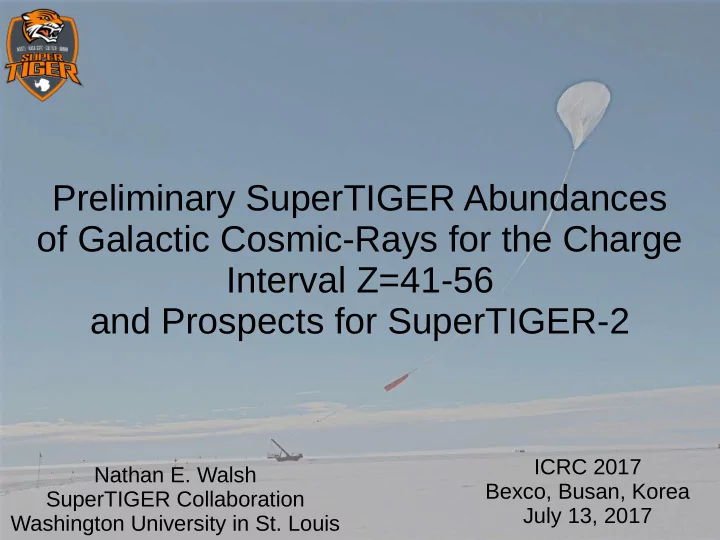

Preliminary SuperTIGER Abundances of Galactic Cosmic-Rays for the Charge Interval Z=41-56 and Prospects for SuperTIGER-2 ICRC 2017 Nathan E. Walsh Bexco, Busan, Korea SuperTIGER Collaboration July 13, 2017 Washington University in St. Louis
SuperTIGER Collaboration N.E. WALSH 1 , W.R. BINNS 1 , R.G. BOSE 1 , D.L. BRAUN 1 , T.J. BRANT 2 , W.M. DANIELS 2 , P.F. DOWKONTT 1 , S.P. FITZSIMMONS 2 , D.J. HAHNE 2 , T. HAMS 2,6 , M.H. ISRAEL 1 , J. KLEMIC 3 , A.W. LABRADOR 3 , J.T. LINK 2,6 , R.A. MEWALDT 3 , J.W. MITCHELL 2 , P. MOORE 1 , R.P. MURPHY 1 , M.A. OLEVITCH 1 , B.F. RAUCH 1 , K. SAKAI 2,6 , F. SAN SEBASTIAN 2 , M. SASAKI 2,6 , G.E. SIMBURGER 1 , E.C. STONE 3 , C.J. WADDINGTON 4 , J.E. WARD 1 , M.E. WIEDENBECK 5 1. Washington University, St. Louis, MO 63130, USA 2. NASA/Goddard Space Flight Center, Greenbelt, MD 20771, USA 3. California Institute of Technology, Pasadena, CA 91125, USA 4. University of Minnesota, Minneapolis, MN 55455, USA 5. Jet Propulsion Laboratory, California Institute of Technology, Pasadena, CA 91109, USA 6. Center for Research and Exploration in Space Science and Technology, Greenbelt, MD 20771, USA 2
Science Objectives ● SuperTIGER measures ultra-heavy Galactic cosmic-rays ● HEAO-3 (1989) resolved even charge peaks in range Z=40 to 60 (left) ● SuperTIGER capable of resolving individual charge peaks in this range with increased statistics (right) 3
Science Objectives ● To improve statistics for Ultra-Heavy Galactic Cosmic Rays (greater than Z=30) ● To attempt to resolve individual element peaks in the charge range Z = 40 to 56 – Tests the mass dependence of the acceleration of refractory elements in GCR ● Current theory suggests that there should be no mass dependence – Tests the r-process enrichment in GCR ● Where do GCR originate? OB associations as a major component? Binary neutron star mergers? 4
Measurement ● Instrument consists of two nearly identical modules ● Aerogel index = 1.04 or 1.025 ● Aerogel threshold = 2.5 GeV/nuc or 3.3 GeV/nuc ● Acrylic index = 1.49 ● Acrylic threshold = 350 MeV/nuc ● Scintillators for charge determination in combination with Cherenkov detectors ● Scintillation light ~ Z ~1.7 ● Cherenkov light ~ Z 2.0 ● Trajectory determined by scintillating fiber hodoscopes 5
Charge Determination Two complimentary methods to cover a wide energy range 6
Elemental Abundances SuperTIGER-2 aims to extend this analysis to the Z=40-56 charge range with increased statistics 7
SuperTIGER vs HEAO-3 High Z Abundances Preliminary SuperTIGER elemental peaks (right) propagated to top of atmosphere and paired to make comparison with HEAO-3 (left) 8
SuperTIGER vs HEAO-3 High Z Abundances 9
Impact of Solar Modulation ● In 2009-10, solar modulation was ~250 MV ● In 2012-13 (ST-I), solar modulation was ~500 MV ● GCR flux 43% lower ● If solar modulation reaches 250 MV, we expect to measure ~43% more GCR flux ● If solar modulation reaches 125 MV, we should see ~77% more GCR 10
Conclusion ● SuperTIGER-I – Preliminary abundances match well with HEAO-3 when even and odd charge peaks are paired – With more statistics, individual element peaks could be resolved up to Z=56 ● SuperTIGER-II – Planning to fly Austral Summer of 2017/18 – Flight to occur during solar minimum – Combined ST-1/ST-2 data sets will greatly increase our statistics in the ultra heavy charge range and allow us to further explore the Z=40-56 charge range 11
Acknowledgements This research was supported by NASA under grants NNX09AC17G and NNX14AB25G, by the McDonnell Center for the Space Sciences at Washington University, and by the Peggy and Steve Fossett Foundation. We thank the NASA Columbia Scientific Balloon Facility, the NASA Balloon Program Office, and the NSF United States Antarctic Program for the excellent and highly professional efforts that resulted in the Thank You! record long-duration balloon flight for SuperTIGER and the successful recovery effort. 12
Extra Slides 13
SuperTIGER vs HEAO-3 High Z Abundances Charge Raw Fe = 10^6 plus/min TOA plus/min HEAO plus/min Counts Fe=10^6 Fe=10^6 30 2280 556.0 31-32 461 112.4 33-34 178 43.4 6.6 49.2 7.5 51.2 3.7 35-36 103 25.1 5.0 28.7 5.7 35.1 3 37-38 121 29.5 5.4 37.6 6.9 39.6 3.1 39-40 56 13.7 3.7 17.4 4.7 22.2 2.6 41-42 43 10.5 3.2 14.1 4.4 15.4 2.1 43-44 18 4.4 2.1 5.6 2.7 4.6 1.2 45-46 10 2.4 1.6 2.7 1.7 6.7 1.4 47-48 14 3.4 1.8 4.6 2.5 5.5 1.3 49-50 19 4.6 2.2 7.1 3.3 6.3 1.5 51-52 14 3.4 1.8 5.5 3.0 5.2 1.4 53-54 19 4.6 2.2 8.4 3.9 3.1 1.2 55-56 3 0.7 0.9 0.9 1.1 6.3 1.6 57-58 5 1.2 1.1 2.0 1.8 3.5 1.3 14 59-60 7 1.7 1.3 3.2 2.5 1.5 1.1
Recommend
More recommend